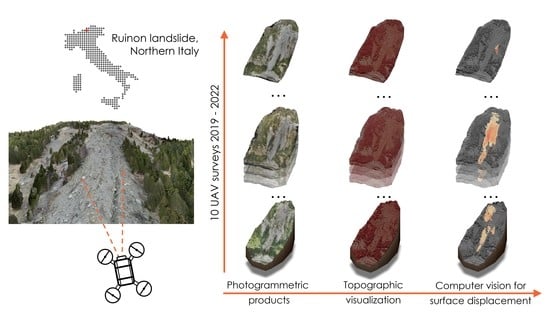Estimating Landslide Surface Displacement by Combining Low-Cost UAV Setup, Topographic Visualization and Computer Vision Techniques
Abstract
1. Introduction
2. Materials and Methods
2.1. Case Study—Ruinon Landslide
2.2. Workflow
2.3. UAV Surveys and Their Outcomes
2.3.1. Period 2019–2020
2.3.2. Period 2021–2022
2.4. Postprocessing
- Spatial sampling of the point clouds to achieve relatively similar density (set to a minimum distance of 10 cm).
- Co-registration of the point clouds: In most cases, Iterative Closest Point (ICP) co-registration was sufficient; when it was not, it was also performed manually using common points between the clouds. The 2019–2020 dataset had unknown accuracy, and it was decided that those epochs should be co-registered according to 2021–2022, specifically, the 6 July 2021 survey was set as a reference point. However, the changes during the 2019–2020 period were severe ,and therefore the moving primary scheme was applied in reverse order, i.e., 19 October 2020 was co-registered to 6 July 2021, 25 October 2019 to 19 October 2020, etc. On the other hand, the epochs in the 2021–2022 period were co-registered using a fixed primary scheme and all three products were transformed according to 6 July 2021. The achieved co-registration error varied among the epochs in the range of 0.20 m < RMS < 0.30 m, and most of the highest values were in the 2019–2021 dataset.
- The co-registered point clouds were rasterized into DSM with a spatial resolution of 10 cm/pix.
- Filtering the resulting DSMs: As the point density was reduced to a certain level, the interpolation of the point cloud into raster led, in some cases, to noisy and irregular terrain, which may further alter the analysis. A Gaussian filter (kernel type—square and radius of 3 pixels) was applied to obtain a more regular and smooth surface product without losing details (e.g., Figure 6).
2.5. Red Relief Image Map
2.6. Dense Optical Flow
2.6.1. Finer Co-Registration
2.6.2. Displacement Computation
3. Results
3.1. RRIM Implementation
3.2. Displacement Computation
4. Discussion
5. Conclusions
Author Contributions
Funding
Data Availability Statement
Acknowledgments
Conflicts of Interest
Abbreviations
| DSGSD | Deep-seated gravitational slope deformation |
| GBInSAR | Ground-Based Interferometric Synthetic Aperture Radar |
| ARPA | Regional Agency for the Protection of the Environment (from Italian) |
| RRIM | Red Relief Image Map |
| UAV | Unmanned Aerial Vehicle |
| FOSS | Free and Open Software Solutions |
| GCPs | Ground Control Points |
| CMOS | Complementary Metal-Oxide-Semiconductor |
| SfM | Structure from Motion |
| MVS | Multi-View Stereo |
| RTK | Real-Time Kinematic |
| DSM | Digital Surface Model |
| ICP | Iterative Closest Point |
| M3C2 | Multiscale Model to Model Cloud Comparison |
| m. a.s.l. | Meters above sea level |
Appendix A
Appendix A.1
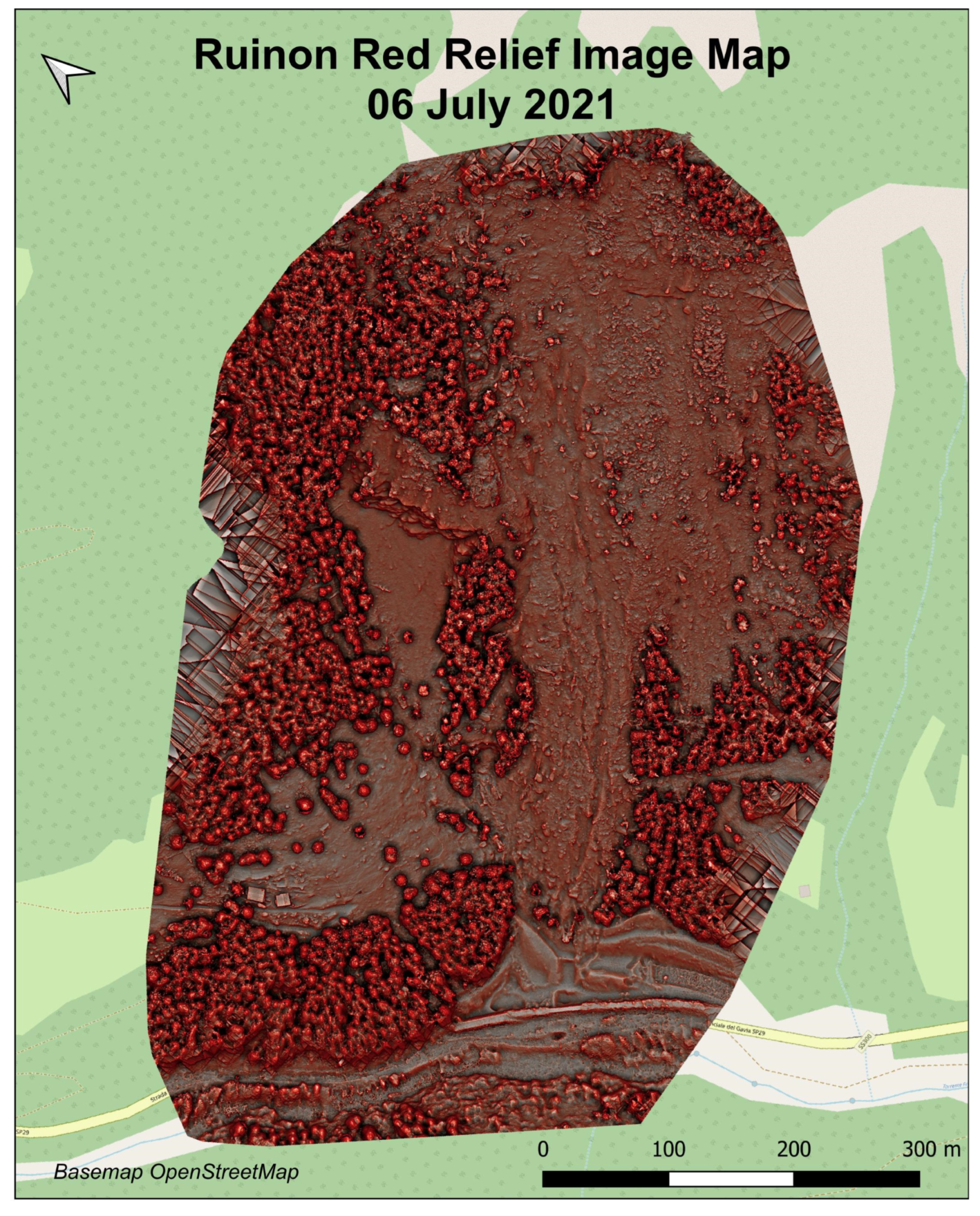
Appendix A.2
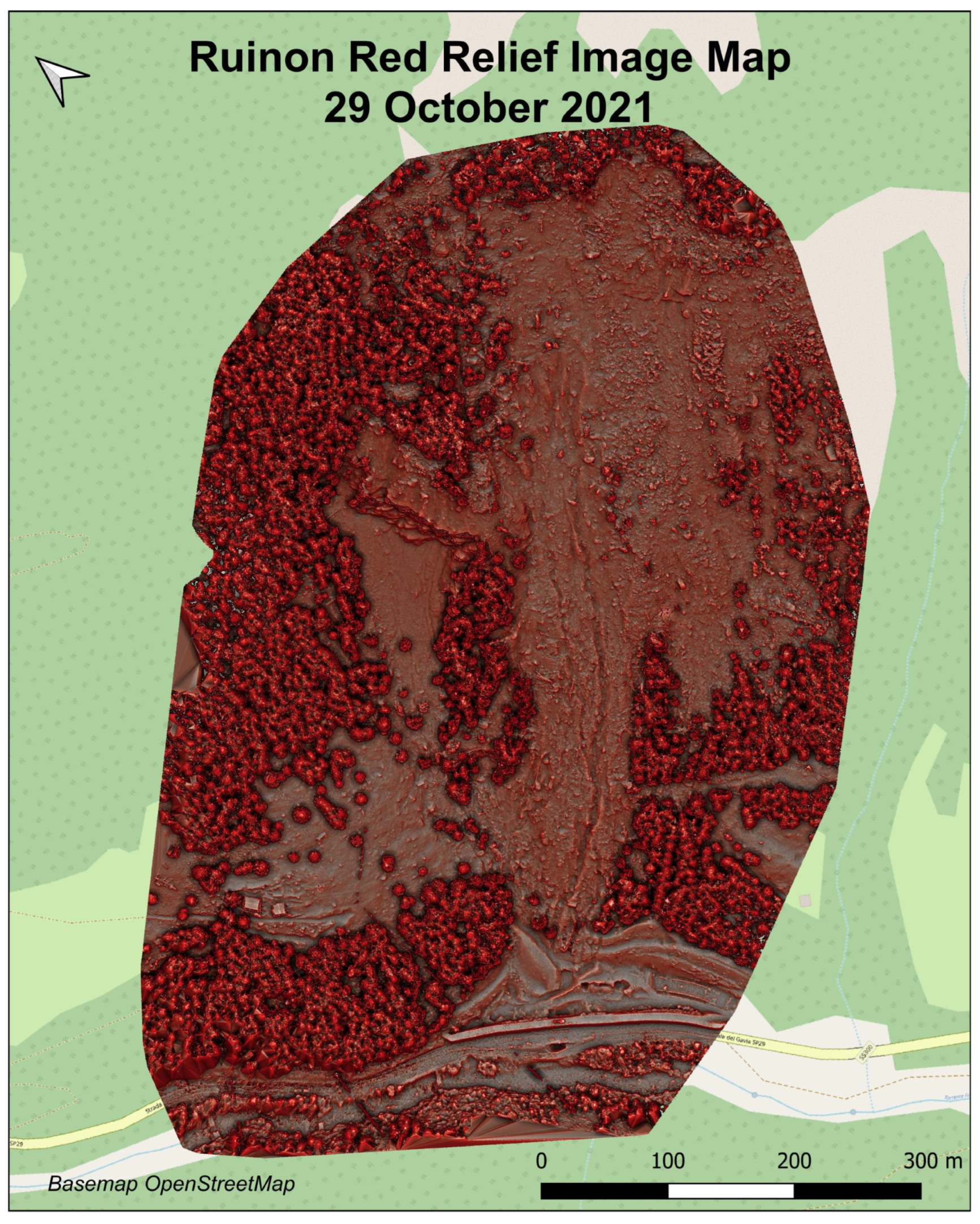
Appendix A.3
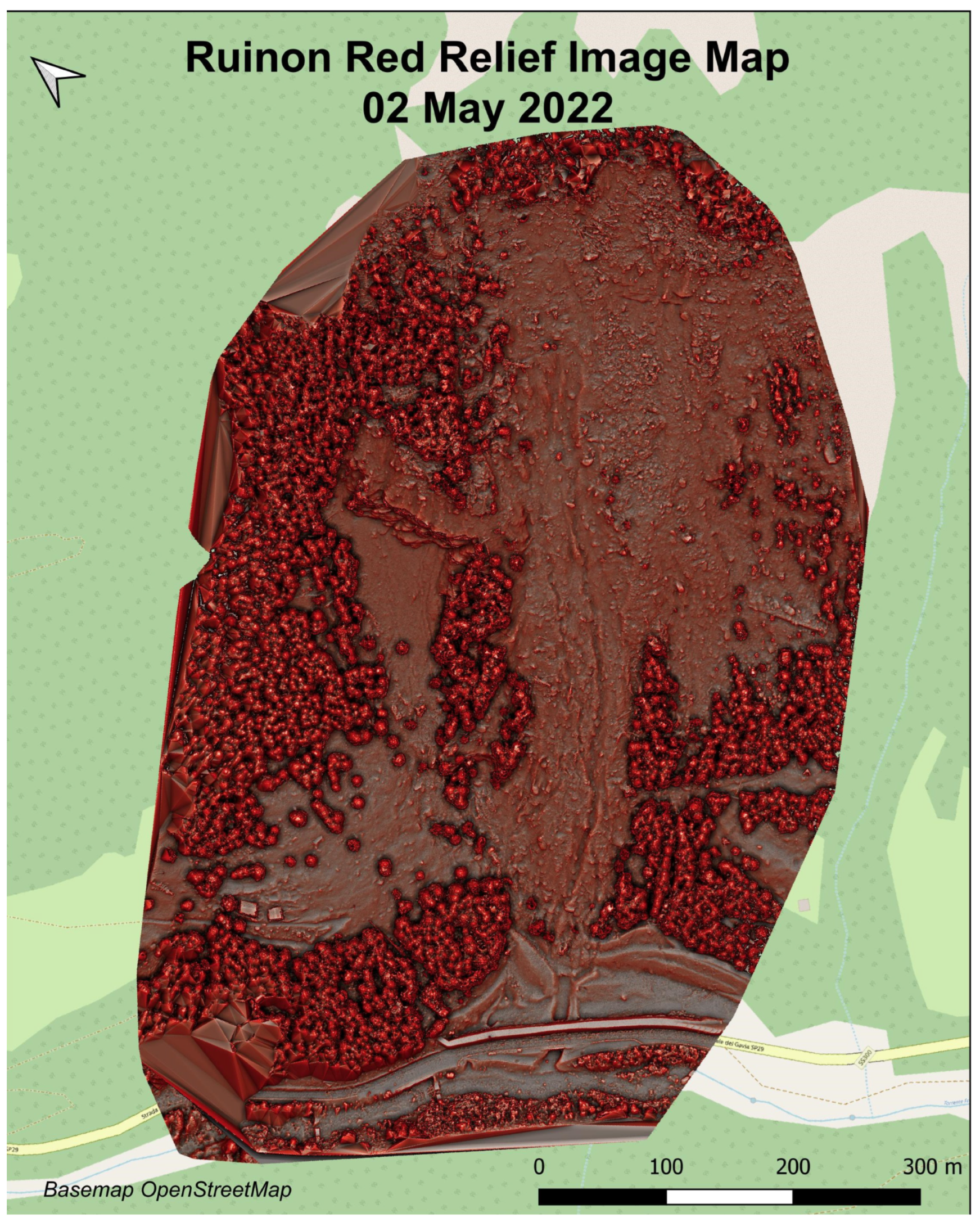
Appendix A.4

References
- Scaioni, M.; Longoni, L.; Melillo, V.; Papini, M. Remote sensing for landslide investigations: An overview of recent achievements and perspectives. Remote Sens. 2014, 6, 9600–9652. [Google Scholar] [CrossRef]
- Pradhan, B.; Lee, S.; Mansor, S.; Buchroithner, M.; Jamaluddin, N.; Khujaimah, Z. Utilization of optical remote sensing data and geographic information system tools for regional landslide hazard analysis by using binomial logistic regression model. J. Appl. Remote Sens. 2008, 2, 023542. [Google Scholar] [CrossRef]
- Hervás, J.; Barredo, J.I.; Rosin, P.L.; Pasuto, A.; Mantovani, F.; Silvano, S. Monitoring landslides from optical remotely sensed imagery: The case history of Tessina landslide, Italy. Geomorphology 2003, 54, 63–75. [Google Scholar] [CrossRef]
- Schönfeldt, E.; Winocur, D.; Pánek, T.; Korup, O. Deep learning reveals one of Earth’s largest landslide terrain in Patagonia. Earth Planet. Sci. Lett. 2022, 593, 117642. [Google Scholar] [CrossRef]
- Mondini, A.C.; Guzzetti, F.; Chang, K.T.; Monserrat, O.; Martha, T.R.; Manconi, A. Landslide failures detection and mapping using Synthetic Aperture Radar: Past, present and future. Earth-Sci. Rev. 2021, 216, 103574. [Google Scholar] [CrossRef]
- Burrows, K.; Marc, O.; Remy, D. Using Sentinel-1 radar amplitude time series to constrain the timings of individual landslides: A step towards understanding the controls on monsoon-triggered landsliding. Nat. Hazards Earth Syst. Sci. 2022, 22, 2637–2653. [Google Scholar] [CrossRef]
- Yordanov, V.; Biagi, L.; Truong, X.Q.; Tran, V.A.; Brovelli, M.A. An Overview of Geoinformatics State-of-the-Art Techniques for Landslide. Int. Arch. Photogramm. Remote Sens. Spat. Inf. Sci. 2021, 46, 205–212. [Google Scholar] [CrossRef]
- Handwerger, A.L.; Jones, S.Y.; Huang, M.H.; Amatya, P.; Kerner, H.R.; Kirschbaum, D.B. Rapid landslide identification using synthetic aperture radar amplitude change detection on the Google Earth Engine. Nat. Hazards Earth Syst. Sci. Discuss. 2020, 2020, 1–24. [Google Scholar] [CrossRef]
- Aslan, G.; Foumelis, M.; Raucoules, D.; De Michele, M.; Bernardie, S.; Cakir, Z. Landslide Mapping and Monitoring Using Persistent Scatterer Interferometry PSI Technique in the French Alps. Remote Sens. 2020, 12, 1305. [Google Scholar] [CrossRef]
- Giordan, D.; Hayakawa, Y.; Nex, F.; Remondino, F.; Tarolli, P. Review article: The use of remotely piloted aircraft systems (RPASs) for natural hazards monitoring and management. Nat. Hazards Earth Syst. Sci. 2018, 18, 1079–1096. [Google Scholar] [CrossRef]
- Valkaniotis, S.; Papathanassiou, G.; Ganas, A. Mapping an earthquake-induced landslide based on UAV imagery; case study of the 2015 Okeanos landslide, Lefkada, Greece. Eng. Geol. 2018, 245, 141–152. [Google Scholar] [CrossRef]
- Kotsi, E.; Vassilakis, E.; Diakakis, M.; Mavroulis, S.; Konsolaki, A.; Filis, C.; Lozios, S.; Lekkas, E. Using UAS-Aided Photogrammetry to Monitor and Quantify the Geomorphic Effects of Extreme Weather Events in Tectonically Active Mass Waste-Prone Areas: The Case of Medicane Ianos. Appl. Sci. 2023, 13, 812. [Google Scholar] [CrossRef]
- Sestras, P.; Bilasco, S.; Rosca, S.; Dudic, B.; Hysa, A.; Spalevic, V. Geodetic and UAV Monitoring in the Sustainable Management of Shallow Landslides and Erosion of a Susceptible Urban Environment. Remote Sens. 2021, 13, 385. [Google Scholar] [CrossRef]
- Godone, D.; Allasia, P.; Borrelli, L.; Gullà, G. UAV and Structure from Motion Approach to Monitor the Maierato Landslide Evolution. Remote Sens. 2020, 12, 1039. [Google Scholar] [CrossRef]
- Casagli, N.; Frodella, W.; Morelli, S.; Tofani, V.; Ciampalini, A.; Intrieri, E.; Raspini, F.; Rossi, G.; Tanteri, L.; Lu, P. Spaceborne, UAV and ground-based remote sensing techniques for landslide mapping, monitoring and early warning. Geoenviron. Disasters 2017, 4, 9. [Google Scholar] [CrossRef]
- Rossi, G.; Tanteri, L.; Tofani, V.; Vannocci, P.; Moretti, S.; Casagli, N. Multitemporal UAV surveys for landslide mapping and characterization. Landslides 2018, 15, 1045–1052. [Google Scholar] [CrossRef]
- Kyriou, A.; Nikolakopoulos, K.; Koukouvelas, I.; Lampropoulou, P. Repeated UAV Campaigns, GNSS Measurements, GIS, and Petrographic Analyses for Landslide Mapping and Monitoring. Minerals 2021, 11, 300. [Google Scholar] [CrossRef]
- Karantanellis, E.; Marinos, V.; Vassilakis, E.; Christaras, B. Object-Based Analysis Using Unmanned Aerial Vehicles (UAVs) for Site-Specific Landslide Assessment. Remote Sens. 2020, 12, 1711. [Google Scholar] [CrossRef]
- Jakopec, I.; Marendi´c, A.; Grgac, I. A Novel Approach to Landslide Monitoring Based on Unmanned Aerial System Photogrammetry. Rud.-Geološko-Naft. Zb. 2022, 37, 83–101. [Google Scholar] [CrossRef]
- Hermle, D.; Gaeta, M.; Krautblatter, M.; Mazzanti, P.; Keuschnig, M. Performance Testing of Optical Flow Time Series Analyses Based on a Fast, High-Alpine Landslide. Remote Sens. 2022, 14, 455. [Google Scholar] [CrossRef]
- Niethammer, U.; James, M.; Rothmund, S.; Travelletti, J.; Joswig, M. UAV-based remote sensing of the Super-Sauze landslide: Evaluation and results. Eng. Geol. 2012, 128, 2–11. [Google Scholar] [CrossRef]
- Xu, Q.; Li, W.; Ju, Y.; Dong, X.; Peng, D. Multitemporal UAV-based photogrammetry for landslide detection and monitoring in a large area: A case study in the Heifangtai terrace in the Loess Plateau of China. J. Mt. Sci. 2020, 17, 1826–1839. [Google Scholar] [CrossRef]
- Niethammer, U.; Rothmund, S.; James, M.R.; Travelletti, J.; Joswig, M. UAV-Based Remote Sensing of Landslides. Int. Arch. Photogramm. Remote Sens. Spat. Inf. Sci. 2010, 38, 496–501. [Google Scholar]
- Lindner, G.; Schraml, K.; Mansberger, R.; Hübl, J. UAV monitoring and documentation of a large landslide. Appl. Geomat. 2016, 8, 1–11. [Google Scholar] [CrossRef]
- Turaga, P.; Chellappa, R.; Veeraraghavan, A. Advances in Video-Based Human Activity Analysis: Challenges and Approaches. Adv. Comput. 2010, 80, 237–290. [Google Scholar] [CrossRef]
- Lucas, B.D.; Kanade, T. An Iterative Image Registration Technique with An Application to Stereo Vision. In Proceedings of the IJCAI’81: 7th international joint conference on Artificial intelligence, Vancouver, BC, Canada, 24–28 August 1981; Volume 2, pp. 674–679. [Google Scholar]
- Chiba, T.; Kaneta, S.I.; Suzuki, Y. Red relief image map: New visualization method for three dimensional data. Int. Arch. Photogramm. Remote Sens. Spat. Inf. Sci. 2008, 37, 1071–1076. [Google Scholar]
- Yokoyama, R. Visualizing Topography by Openness:A New Application of Image Processing to Digital Elevation Models. Photogramm. Eng. Remote Sens. 2002, 68, 257–265. [Google Scholar]
- Chen, R.F.; Lin, C.W.; Chen, Y.H.; He, T.C.; Fei, L.Y. Detecting and Characterizing Active Thrust Fault and Deep-Seated Landslides in Dense Forest Areas of Southern Taiwan Using Airborne LiDAR DEM. Remote Sens. 2015, 7, 15443–15466. [Google Scholar] [CrossRef]
- Fang, C.; Fan, X.; Zhong, H.; Lombardo, L.; Tanyas, H.; Wang, X. A Novel Historical Landslide Detection Approach Based on LiDAR and Lightweight Attention U-Net. Remote Sens. 2022, 14, 4357. [Google Scholar] [CrossRef]
- Agliardi, F.; Crosta, G.; Zanchi, A. Structural constraints on deep-seated slope deformation kinematics. Eng. Geol. 2001, 59, 83–102. [Google Scholar] [CrossRef]
- Tarchi, D.; Casagli, N.; Moretti, S.; Leva, D.; Sieber, A.J. Monitoring landslide displacements by using ground-based synthetic aperture radar interferometry: Application to the Ruinon landslide in the Italian Alps. J. Geophys. Res. Solid Earth 2003, 108. [Google Scholar] [CrossRef]
- Rete di Monitoraggio di Ruinon. Available online: https://www.arpalombardia.it:443/Pages/Monitoraggio-geologico/Le-aree-monitorate/RUINION.aspx (accessed on 1 September 2022).
- Del Ventisette, C.; Casagli, N.; Fortuny-Guasch, J.; Tarchi, D. Ruinon landslide (Valfurva, Italy) activity in relation to rainfall by means of GBInSAR monitoring. Landslides 2012, 9, 497–509. [Google Scholar] [CrossRef]
- Antonello, G.; Casagli, N.; Farina, P.; Leva, D.; Nico, G.; Sieber, A.J.; Tarchi, D. Ground-based SAR interferometry for monitoring mass movements. Landslides 2004, 1, 21–28. [Google Scholar] [CrossRef]
- Carlà, T.; Gigli, G.; Lombardi, L.; Nocentini, M.; Casagli, N. Monitoring and analysis of the exceptional displacements affecting debris at the top of a highly disaggregated rockslide. Eng. Geol. 2021, 294, 106345. [Google Scholar] [CrossRef]
- Amici, L.; Yordanov, V.; Oxoli, D.; Truong, X.Q.; Brovelli, M.A. Monitoring landslide displacements through maximum cross-correlation of satellite images. Int. Arch. Photogramm. Remote Sens. Spat. Inf. Sci. 2022, XLVIII-4/W1-2022, 27–34. [Google Scholar] [CrossRef]
- Di Valfurva, C. Press Release from 18 January 2022. Available online: https://www.comune.valfurva.so.it/comunicato-stampa-del-18012022 (accessed on 1 September 2022).
- Authors, O. ODM—A Command Line Toolkit to Generate Maps, Point Clouds, 3D Models and DEMs from Drone, Balloon or Kite Images. Available online: https://github.com/OpenDroneMap/ODM (accessed on 1 September 2022).
- Team, C.D. CloudCompare. Available online: http://www.cloudcompare.org/ (accessed on 1 September 2022).
- Relief Visualization Toolbox in Python. Available online: https://github.com/EarthObservation/RVT_py (accessed on 1 September 2022).
- Walt, S.V.D.; Schönberger, J.L.; Nunez-Iglesias, J.; Boulogne, F.; Warner, J.D.; Yager, N.; Gouillart, E.; Yu, T. scikit-image: Image processing in Python. PeerJ 2014, 2, e453. [Google Scholar] [CrossRef] [PubMed]
- Yordanov, V.; Biagi, L.; Truong, X.Q.; Brovelli, M.A. Landslide surveys using low-cost UAV and FOSS photogrammetric workflow. Int. Arch. Photogramm. Remote Sens. Spat. Inf. Sci. 2022, XLIII-B2-2022, 493–499. [Google Scholar] [CrossRef]
- Yordanov, V.; Fugazza, D.; Azzoni, R.; Cernuschi, M.; Scaioni, M.; DIolaiuti, G. Monitoring alpine glaciers from close-range to satellite sensors. Int. Arch. Photogramm. Remote Sens. Spat. Inf. Sci. 2019, 42, 1803–1810. [Google Scholar] [CrossRef]
- Yordanov, V.; Mostafavi, A.; Scaioni, M. Distance-Training for image-based 3d modelling of archeological sites in remote regions. Int. Arch. Photogramm. Remote Sens. Spat. Inf. Sci. 2019, 42, 1165–1172. [Google Scholar] [CrossRef]
- Commission Implementing Regulation (EU) 2019/947 of 24/05/2019 on the Rules and Procedures for the Operation of Unmanned Aircraft. 2019. Available online: https://eur-lex.europa.eu/eli/reg_impl/2019/947 (accessed on 1 September 2022).
- JMG30. Flight Planner. Available online: https://github.com/JMG30/flight_planner (accessed on 1 September 2022).
- Team, Q.D. QGIS Geographic Information System. Open Source Geospatial Foundation Project. 2020. Available online: http://qgis.osgeo.org (accessed on 1 September 2022).
- Kokalj, Z.; Somrak, M. Why Not a Single Image? Combining Visualizations to Facilitate Fieldwork and On-Screen Mapping. Remote Sens. 2019, 11, 747. [Google Scholar] [CrossRef]
- Alvarez, L.; Weickert, J.; Sánchez, J. Reliable Estimation of Dense Optical Flow Fields with Large Displacements. Int. J. Comput. Vis. 2000, 39, 41–56. [Google Scholar] [CrossRef]
- Pantilie, C.D.; Bota, S.; Haller, I.; Nedevschi, S. Real-time obstacle detection using dense stereo vision and dense optical flow. In Proceedings of the 2010 IEEE 6th International Conference on Intelligent Computer Communication and Processing, Cluj-Napoca, Romania, 26–28 August 2010; pp. 191–196. [Google Scholar] [CrossRef]
- Kollnig, H.; Nagel, H.H.; Otte, M. Association of motion verbs with vehicle movements extracted from dense optical flow fields. In Proceedings of the Computer Vision—ECCV ’94, Stockholm, Sweden, 2–6 May 1994; Eklundh, J.O., Ed.; Lecture Notes in Computer Science. Springer: Berlin/Heidelberg, Germany, 1994; pp. 338–347. [Google Scholar] [CrossRef]
- Lenzano, M.; Lannutti, E.; Toth, C.; Rivera, A.; Lenzano, L. Detecting Glacier Surface Motion by Optical Flow. Photogramm. Eng. Remote Sens. 2018, 84, 33–42. [Google Scholar] [CrossRef]
- Vogel, C.; Bauder, A.; Schindler, K. Optical Flow for Glacier Motion Estimation. ISPRS Ann. Photogramm. Remote Sens. Spat. Inf. Sci. 2012, I–3, 359–364. [Google Scholar] [CrossRef]
- Le Besnerais, G.; Champagnat, F. Dense optical flow by iterative local window registration. In Proceedings of the IEEE International Conference on Image Processing 2005, Genova, Italy, 14 September 2005; Volume 1, pp. 1–137. [Google Scholar] [CrossRef]
- Yordanov, V.; Truong, X.Q.; Brovelli, M.A. Red Relief Image Maps of the Ruinon Landslide, Northern Italy (2021–2022). Available online: https://zenodo.org/record/7534990 (accessed on 1 January 2023).
- Lague, D.; Brodu, N.; Leroux, J. Accurate 3D comparison of complex topography with terrestrial laser scanner: Application to the Rangitikei canyon (N-Z). ISPRS J. Photogramm. Remote Sens. 2013, 82, 10–26. [Google Scholar] [CrossRef]
- Jaboyedoff, M.; Carrea, D.; Derron, M.H.; Oppikofer, T.; Penna, I.M.; Rudaz, B. A review of methods used to estimate initial landslide failure surface depths and volumes. Eng. Geol. 2020, 267, 105478. [Google Scholar] [CrossRef]
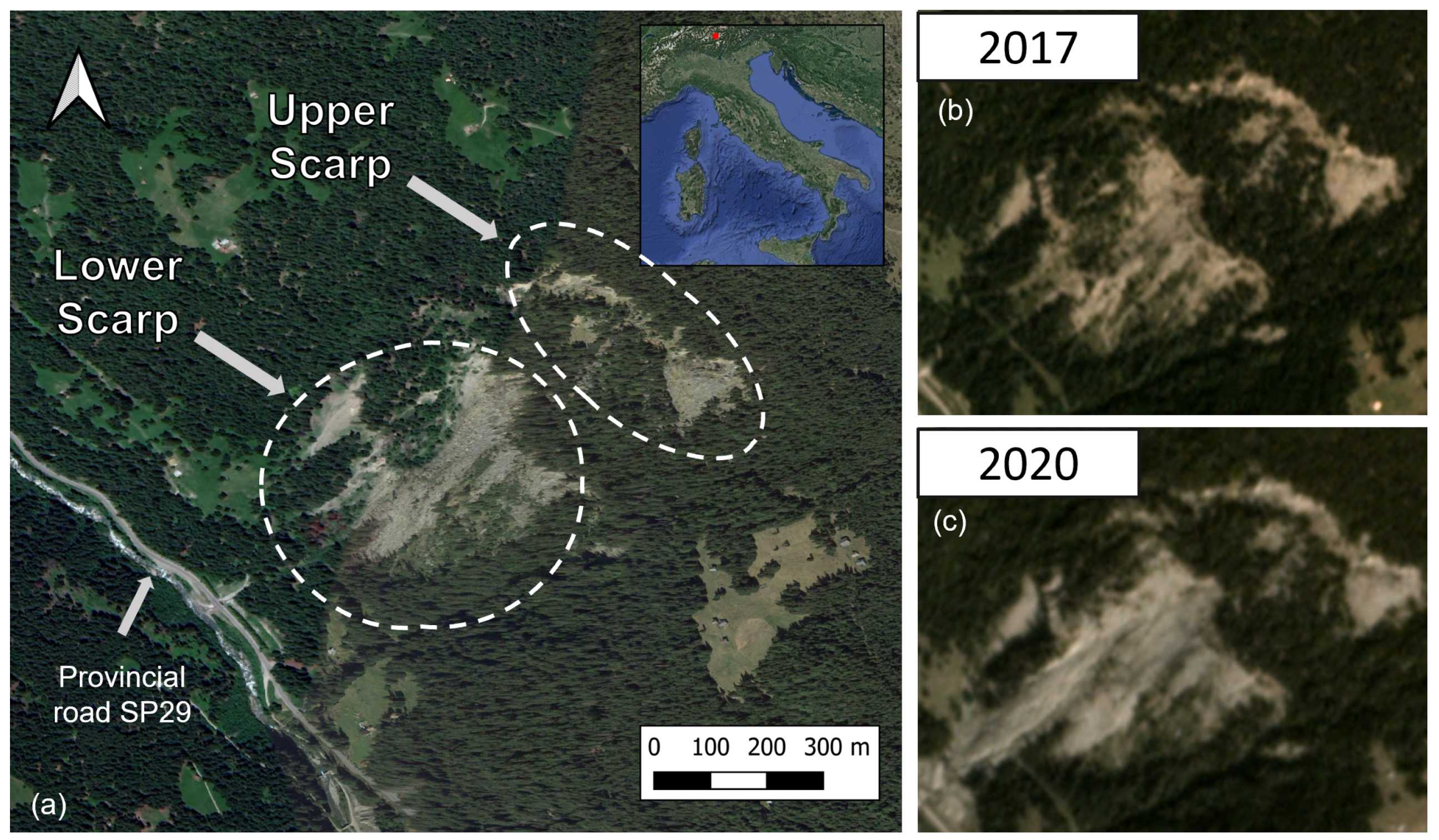
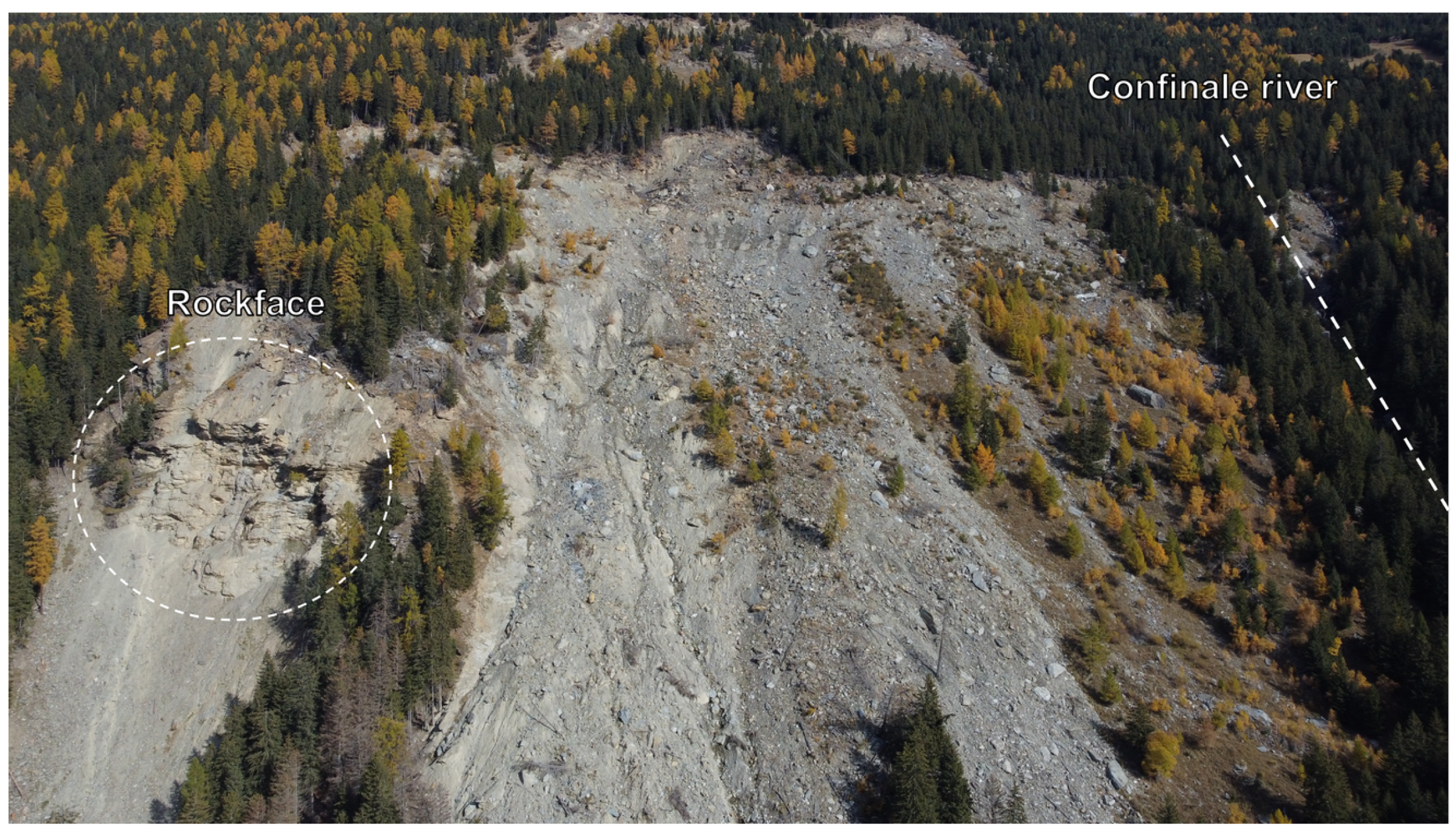

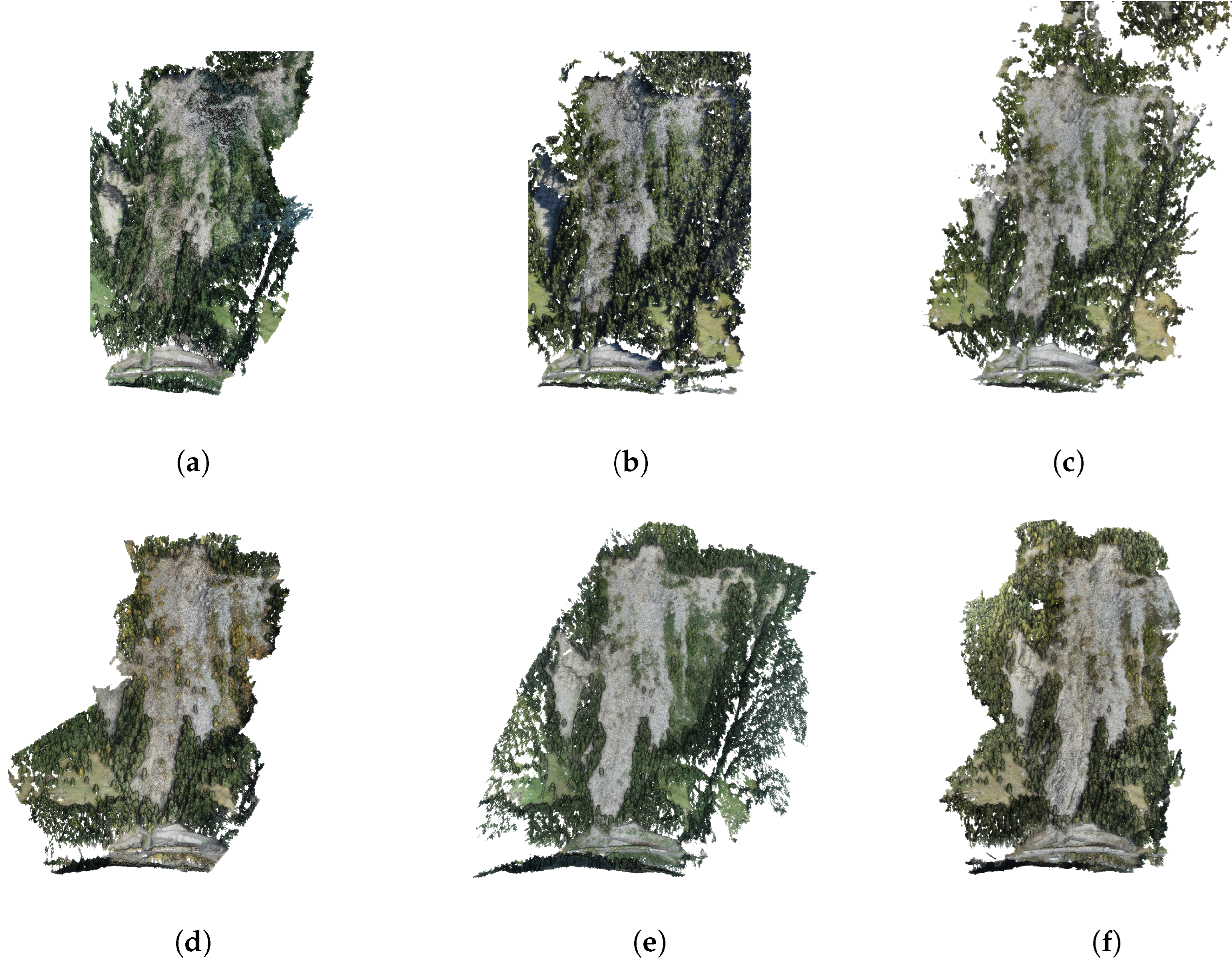

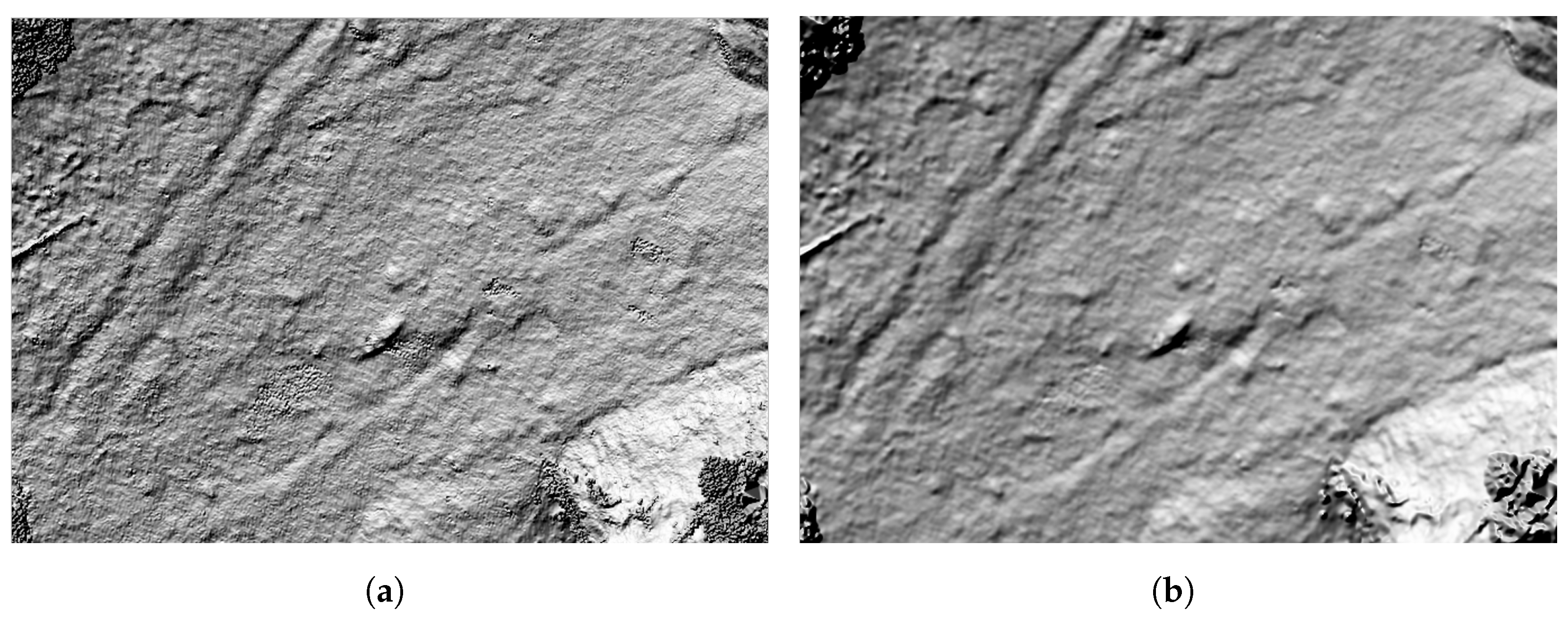
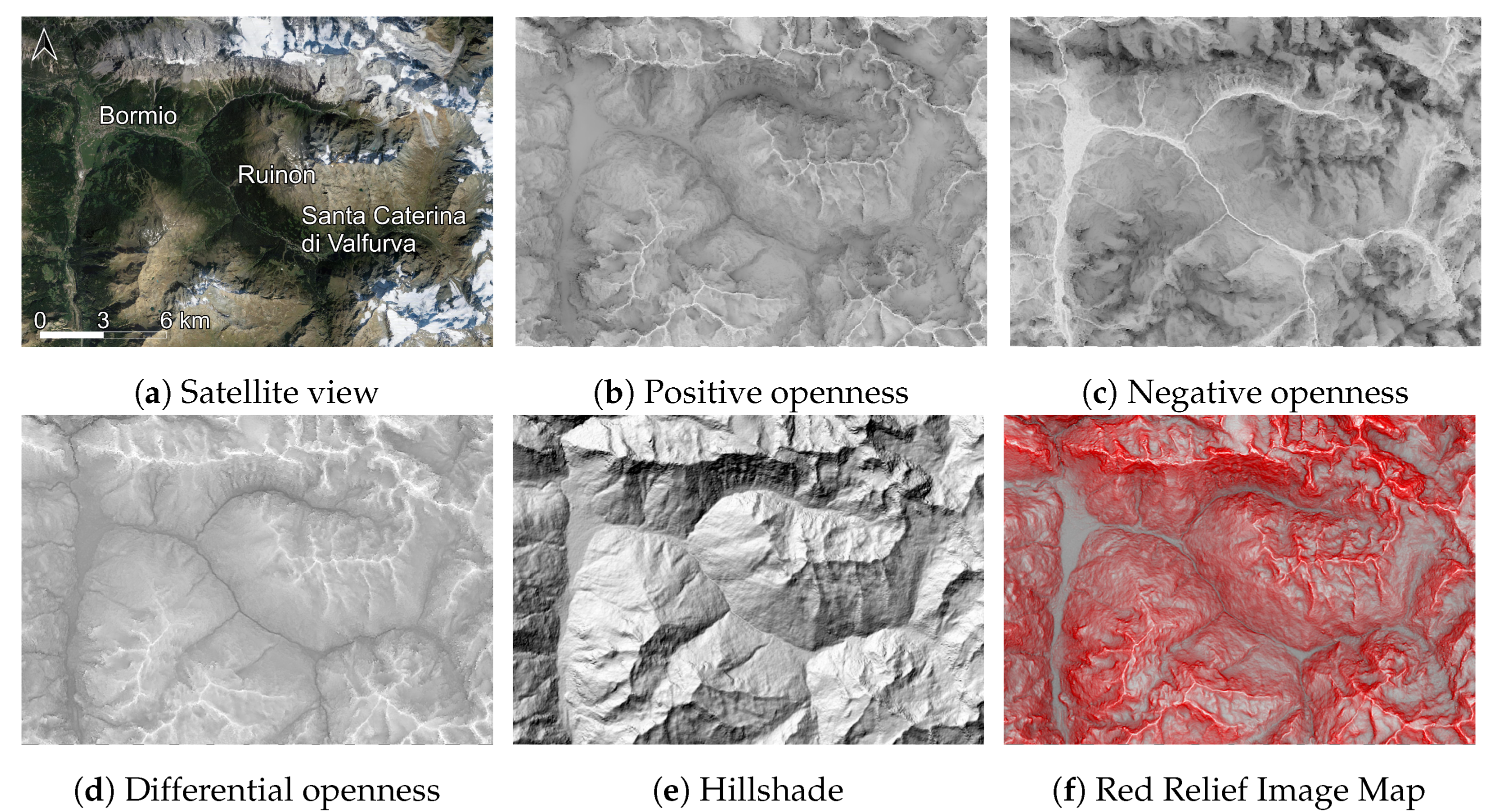

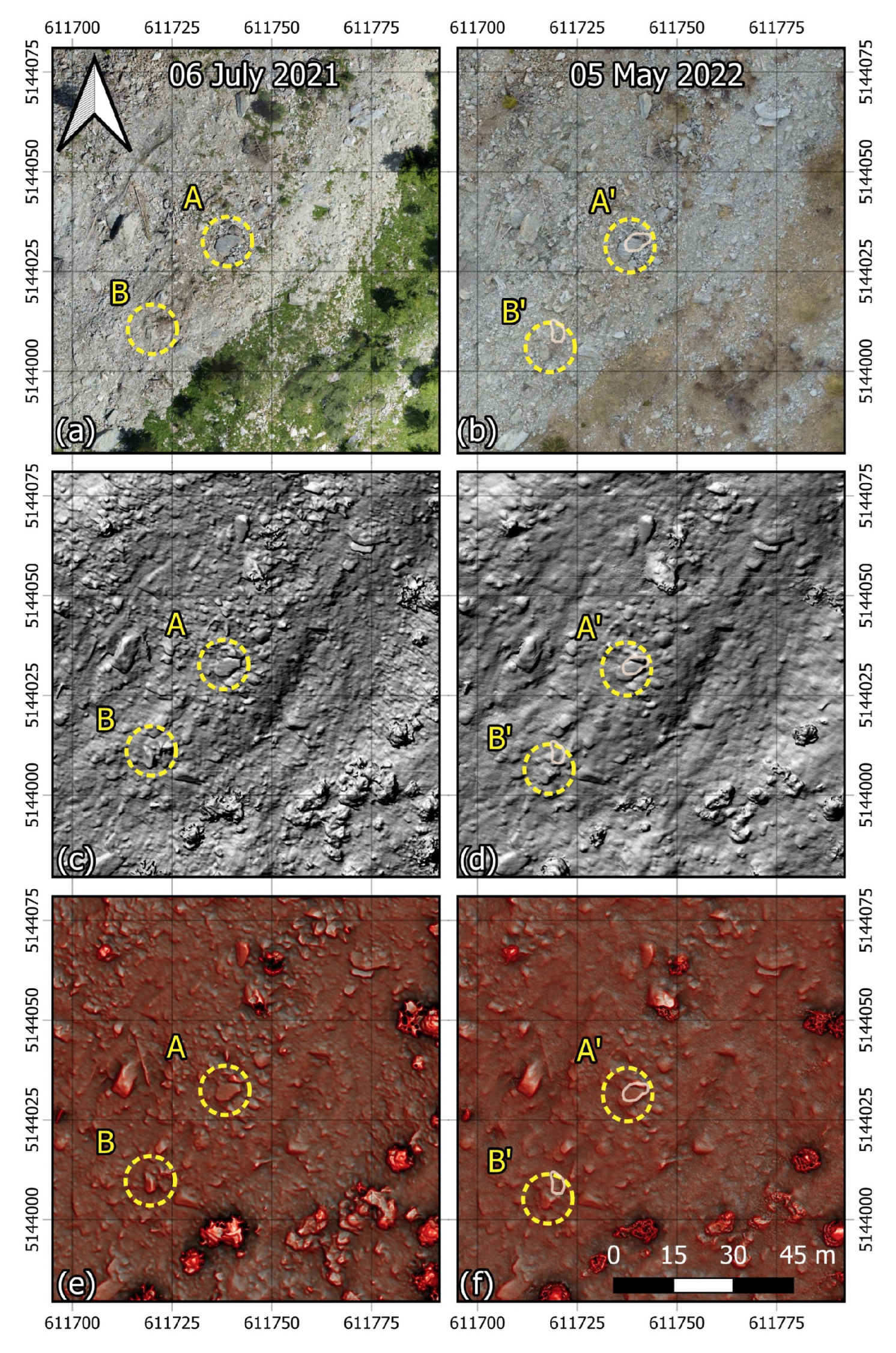
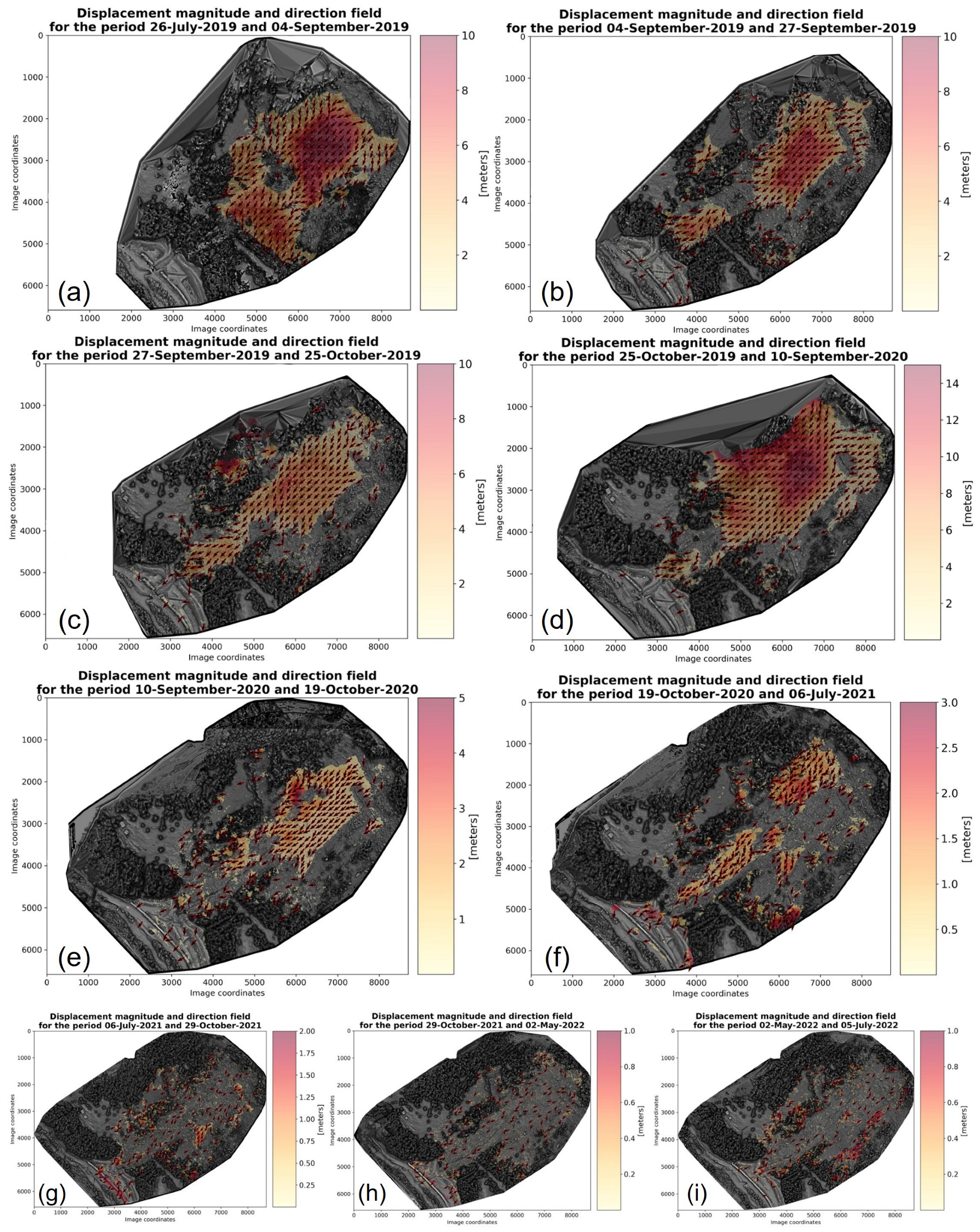
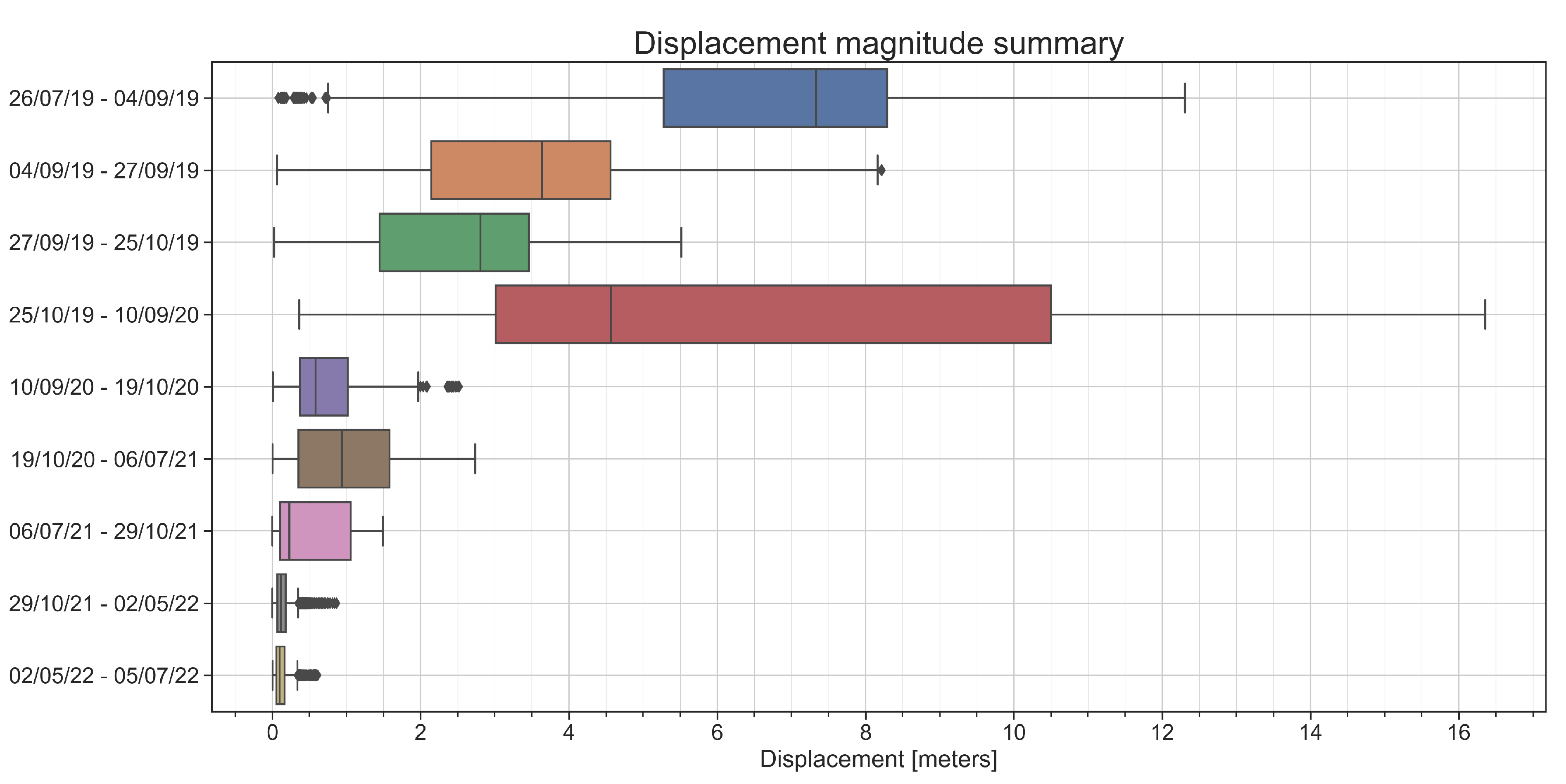

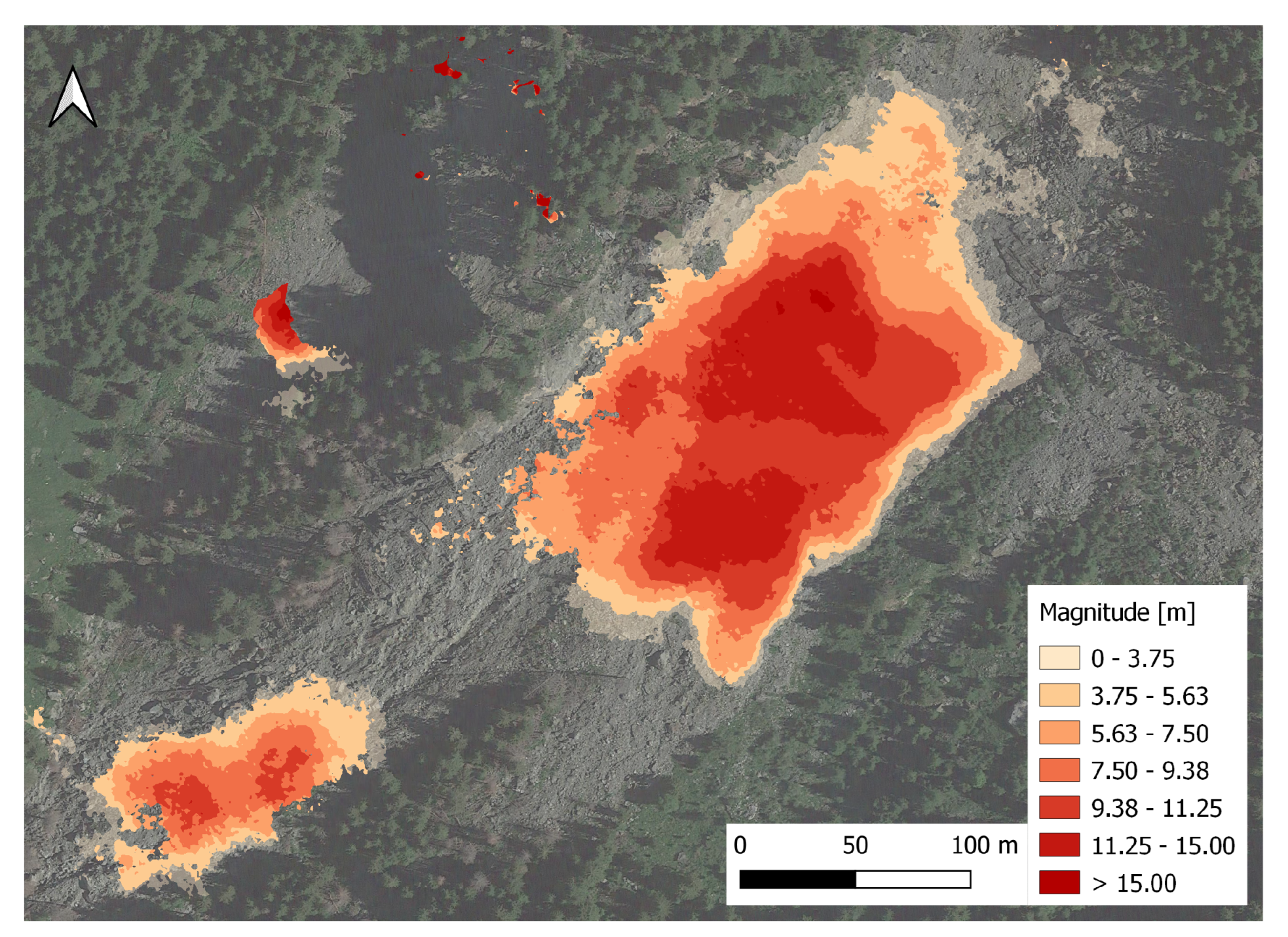
| 26 July 2019 | 4 September 2019 | 27 September 2019 | 25 October 2019 | 10 September 2020 | 19 October 2020 | |
|---|---|---|---|---|---|---|
| Total points | 12,807,656 | 21,408,313 | 21,835,284 | 81,466,454 | 53,722,814 | 116,372,943 |
| GCPs | X | X | X | X | X | X |
| Area covered [km] | 0.63 | 0.75 | 0.67 | 0.62 | 0.71 | 0.69 |
| Point density [pts/m] | 20 | 28 | 33 | 130 | 75 | 168 |
| 6 July 2021 | 29 October 2021 | 2 May 2022 | 5 July 2022 | |
|---|---|---|---|---|
| Total points | 297,421,177 | 407,189,985 | 438,663,249 | 136,304,323 |
| GCPs | X | |||
| GCP RMS error [m] | 0.15 | X | 0.16 | 0.13 |
| Area covered [km] | 0.45 | 0.52 | 0.45 | 0.45 |
| Point density [pts/m] | 653 | 783 | 975 | 303 |
Disclaimer/Publisher’s Note: The statements, opinions and data contained in all publications are solely those of the individual author(s) and contributor(s) and not of MDPI and/or the editor(s). MDPI and/or the editor(s) disclaim responsibility for any injury to people or property resulting from any ideas, methods, instructions or products referred to in the content. |
© 2023 by the authors. Licensee MDPI, Basel, Switzerland. This article is an open access article distributed under the terms and conditions of the Creative Commons Attribution (CC BY) license (https://creativecommons.org/licenses/by/4.0/).
Share and Cite
Yordanov, V.; Truong, Q.X.; Brovelli, M.A. Estimating Landslide Surface Displacement by Combining Low-Cost UAV Setup, Topographic Visualization and Computer Vision Techniques. Drones 2023, 7, 85. https://doi.org/10.3390/drones7020085
Yordanov V, Truong QX, Brovelli MA. Estimating Landslide Surface Displacement by Combining Low-Cost UAV Setup, Topographic Visualization and Computer Vision Techniques. Drones. 2023; 7(2):85. https://doi.org/10.3390/drones7020085
Chicago/Turabian StyleYordanov, Vasil, Quang Xuan Truong, and Maria Antonia Brovelli. 2023. "Estimating Landslide Surface Displacement by Combining Low-Cost UAV Setup, Topographic Visualization and Computer Vision Techniques" Drones 7, no. 2: 85. https://doi.org/10.3390/drones7020085
APA StyleYordanov, V., Truong, Q. X., & Brovelli, M. A. (2023). Estimating Landslide Surface Displacement by Combining Low-Cost UAV Setup, Topographic Visualization and Computer Vision Techniques. Drones, 7(2), 85. https://doi.org/10.3390/drones7020085







